Wednesday, March 18th 2020

Sony Reveals PS5 Hardware: RDNA2 Raytracing, 16 GB GDDR6, 6 GB/s SSD, 2304 GPU Cores
Sony in a YouTube stream keynote by PlayStation 5 lead system architect Mark Cerny, detailed the upcoming entertainment system's hardware. There are three key areas where the company has invested heavily in driving forward the platform by "balancing revolutionary and evolutionary" technologies. A key design focus with PlayStation 5 is storage. Cerny elaborated on how past generations of the PlayStation guided game developers' art direction as the low bandwidths and latencies of optical discs and HDDs posed crippling latencies arising out of mechanical seeks, resulting in infinitesimally lower data transfer rates than what the media is capable of in best case scenario (seeking a block of data from its outermost sectors). SSD was the #1 most requested hardware feature by game developers during the development of PS5, and Sony responded with something special.
Each PlayStation 5 ships with a PCI-Express 4.0 x4 SSD with a flash controller that has been designed in-house by Sony. The controller features 12 flash channels, and is capable of at least 5.5 GB/s transfer speeds. When you factor in the exponential gains in access time, Sony expects the SSD to provide a 100x boost in effective storage sub-system performance, resulting in practically no load times.The secret sauce here is that Sony is using its own protocol instead of NVMe, in supporting 6 data priority tiers versus 2 on NVMe. Each PlayStation 5 ships with an 825 GB SSD, which is expandable using external HDDs over USB, or a selection of third-party M.2 NVMe SSDs certified by Sony. PlayStation 4 games can run directly off your external HDD, but PlayStation 5 games have to be transferred from your HDD to the console's main SSD. Past generations of PlayStation implemented ZLib data compression on Blu-ray and HDD media. PlayStation 5 is implementing Kraken, with hardware-accelerated de-compression via fixed-function hardware built directly into the main SoC.
SoC is where Cerny sounded restrained in what he wanted to disclose. The SoC is a semi-custom chip designed by Sony and AMD, possibly on a 7 nm-class silicon fabrication process. Sony won't specify if it is a monolithic silicon or an MCM, but there are three building-blocks to it: CPU, GPU, and I/O complex. The CPU is based on AMD "Zen 2" x86-64 microarchitecture, and the GPU is based on the company's upcoming RDNA2 graphics architecture.
There are eight "Zen 2" CPU cores, although the company didn't mention if SMT is featured. The maximum CPU clock speed is 3.50 GHz. The GPU is a whole different story from the one on the Xbox Series X Velocity Engine semi-custom chip. Sony decided to go with 36 RDNA2 compute units ticking at up to 2.23 GHz engine clock, compared to 52 compute units running at up to 1.825 GHz on the upcoming Xbox. Sony's GPU ends up with up to 10.3 TFLOPs max compute throughput, compared to Microsoft's 12 TFLOPs.
Sony also shed some "light" on the hardware-accelerated real-time ray-tracing approach AMD is taking with RDNA2. Apparently, each compute unit features a hardware component called "Intersection Engine," with roughly the same function as an RT core on NVIDIA "Turing," which is to calculate the intersection of rays with geometry (such as triangles or polygons) in a scene. This combines with a fairly standardized bounding volume hierarchy (BVH) model to achieve a hybrid of ray-traced elements in an otherwise conventional rasterized 3D scene (pretty much where NVIDIA is right now with RTX). On PlayStation 5, RDNA2's ray-tracing hardware is leveraged for positional audio, global illumination, shadows, reflections, and full ray-tracing.
The third key component of the SoC is the I/O complex. This handles all of the chip's I/O, not just with peripherals and video output, but also storage and memory. There are dedicated I/O co-processors on-silicon designed to reduce the various I/O's processing stack on the CPU cores, and reduce latencies at various stages. There's also a certain amount of SRAM that caches transfers between the various components on the I/O complex. The custom chip leverages AMD SmartShift in power-management.
PlayStation 5 uses 16 GB of GDDR6 memory. Sony did not mention the memory clock, bandwidth, or even the memory bus width. It did drop some hints about memory management. It appears like PlayStation 5 does not partition memory the way Xbox Series X does, and possibly sticks to the hUMA model of the PlayStation 4 (using a common pool of physical memory for system- and video memory).
Lastly, a large chunk of Sony's presentation focused on the next frontier for hardware innovation: positional audio. Sony is investing heavily on positional audio that takes into account the gamer's physical HRTF (head-related transfer function). The company is leveraging the vast amounts of CPU power gained from the upgrade to "Zen 2," to achieve this.We still don't know what a PlayStation 5 console will look like.
Source:
Sony Computer Entertainment (YouTube)
Each PlayStation 5 ships with a PCI-Express 4.0 x4 SSD with a flash controller that has been designed in-house by Sony. The controller features 12 flash channels, and is capable of at least 5.5 GB/s transfer speeds. When you factor in the exponential gains in access time, Sony expects the SSD to provide a 100x boost in effective storage sub-system performance, resulting in practically no load times.The secret sauce here is that Sony is using its own protocol instead of NVMe, in supporting 6 data priority tiers versus 2 on NVMe. Each PlayStation 5 ships with an 825 GB SSD, which is expandable using external HDDs over USB, or a selection of third-party M.2 NVMe SSDs certified by Sony. PlayStation 4 games can run directly off your external HDD, but PlayStation 5 games have to be transferred from your HDD to the console's main SSD. Past generations of PlayStation implemented ZLib data compression on Blu-ray and HDD media. PlayStation 5 is implementing Kraken, with hardware-accelerated de-compression via fixed-function hardware built directly into the main SoC.
SoC is where Cerny sounded restrained in what he wanted to disclose. The SoC is a semi-custom chip designed by Sony and AMD, possibly on a 7 nm-class silicon fabrication process. Sony won't specify if it is a monolithic silicon or an MCM, but there are three building-blocks to it: CPU, GPU, and I/O complex. The CPU is based on AMD "Zen 2" x86-64 microarchitecture, and the GPU is based on the company's upcoming RDNA2 graphics architecture.
There are eight "Zen 2" CPU cores, although the company didn't mention if SMT is featured. The maximum CPU clock speed is 3.50 GHz. The GPU is a whole different story from the one on the Xbox Series X Velocity Engine semi-custom chip. Sony decided to go with 36 RDNA2 compute units ticking at up to 2.23 GHz engine clock, compared to 52 compute units running at up to 1.825 GHz on the upcoming Xbox. Sony's GPU ends up with up to 10.3 TFLOPs max compute throughput, compared to Microsoft's 12 TFLOPs.
Sony also shed some "light" on the hardware-accelerated real-time ray-tracing approach AMD is taking with RDNA2. Apparently, each compute unit features a hardware component called "Intersection Engine," with roughly the same function as an RT core on NVIDIA "Turing," which is to calculate the intersection of rays with geometry (such as triangles or polygons) in a scene. This combines with a fairly standardized bounding volume hierarchy (BVH) model to achieve a hybrid of ray-traced elements in an otherwise conventional rasterized 3D scene (pretty much where NVIDIA is right now with RTX). On PlayStation 5, RDNA2's ray-tracing hardware is leveraged for positional audio, global illumination, shadows, reflections, and full ray-tracing.
The third key component of the SoC is the I/O complex. This handles all of the chip's I/O, not just with peripherals and video output, but also storage and memory. There are dedicated I/O co-processors on-silicon designed to reduce the various I/O's processing stack on the CPU cores, and reduce latencies at various stages. There's also a certain amount of SRAM that caches transfers between the various components on the I/O complex. The custom chip leverages AMD SmartShift in power-management.
PlayStation 5 uses 16 GB of GDDR6 memory. Sony did not mention the memory clock, bandwidth, or even the memory bus width. It did drop some hints about memory management. It appears like PlayStation 5 does not partition memory the way Xbox Series X does, and possibly sticks to the hUMA model of the PlayStation 4 (using a common pool of physical memory for system- and video memory).
Lastly, a large chunk of Sony's presentation focused on the next frontier for hardware innovation: positional audio. Sony is investing heavily on positional audio that takes into account the gamer's physical HRTF (head-related transfer function). The company is leveraging the vast amounts of CPU power gained from the upgrade to "Zen 2," to achieve this.We still don't know what a PlayStation 5 console will look like.
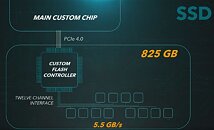
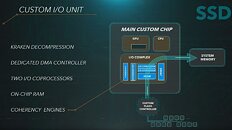
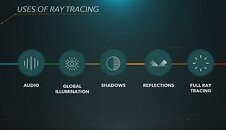
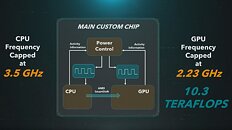
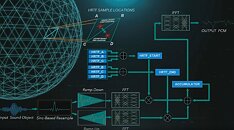
178 Comments on Sony Reveals PS5 Hardware: RDNA2 Raytracing, 16 GB GDDR6, 6 GB/s SSD, 2304 GPU Cores
To expand storage you can use regular m2-nvme-ssd's.
Also there's "3d Audio" support with the "Tempest Engine" which also works with a Stereo setup.
(Which is similar to the Synergistic Processor Unit used in the Sony in de PlayStation 3)
tweakers.net/nieuws/164788/playstation-5-krijgt-gpu-met-36-cus-op-2-komma-3ghz-en-825gb-ssd-die-5-komma-5gb-s-haalt.html
Looks like PS5 has more tailored things, especially the GPU cache coherency managers. And it will end up much cooler too imho.
Xbox has more brute force power, PS5 has faster base speeds and throughput.
Xbox will eke out a few more FPS for the games that demand pure FPS and possibly at higher resolutions. Sony instead offers seamless transition and more dynamic movement; going by how much they've hyped their storage setup and their earlier Spiderman demo (and previous discussion on how character movements were limited by the read speeds of SSDs/HDDs).
The caveat though is that the Xbox seems redundant now that they're sharing releases with PC and thus is going for more of an all-in-one media center with their new Xbox (still a gaming powerhouse, but nevertheless overshadowed by parallel/near-parallel releases with PC), whereas Sony still gets some exclusives and still presents a gaming-first mindset. The ideal combo is looking to be PC + PS5. PC for all the new games releasing alongside Series X on top of an existing Steam/GoG/etc library, and PS5 for exclusives + media center functionality.
Now if only Sony would just release a PSP/Vita successor using AMD's APUs or embedded architecture and offer that seamless transition between on-the-go and at-home-gaming (start a game on one, pick up where you left off on the other, etc).
It gives the impression that it was stretched at the last minute, just to reach the double digit 10TF and not feel much weaker than the Xbox Series X.
Also, this presentation was recorded before XSX announcement, Eurogamer, for example, saw it a couple of days ago, so a last minute bump in frequency is very unlikely. He said "we" would be happy with their cooling solution though. Whatever that's worth.
Not a console gamer, but the hardware is intriguing none the less. We've gone from fairly fixed usage devices to what can only be described as one high-end-ish PC running Windows and another running Linux.
With how much power is being proclaimed by Microsoft and Sony regarding their GPU's and CPU's, its hard to imagine they can release this at even a reasonable price. But if RDNA2 is that good, then I am glad I am hanging onto my GTX 1070 till those GPU's come out.
Not counting the usual "slim" versions, of course.
Anyway, it is far from being a weak console, 10TF GPU, together with a CPU that makes Jaguar look like from last century, plus super fast SSD, will give a fantastic experience.
With these specs, I start to think that they are probably aiming for $399. And at this price, I have no doubt that it will be a success. I don't see the Xbox Series X being sold for less than $500~$550.
It will be particularly interesting to see these consoles in 3-4 years when the games will become more demanding for hardware resources.
12 vs 10.3 is not much of a difference, especially when you have a locked FPS at 60 or so.